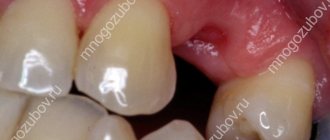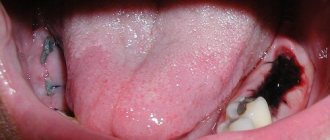How to remove cheek swelling from a tooth.
Swelling of the cheek can be the result of a great variety of reasons, of which there are more than a dozen, and inflammation, as a result of which the swelling is formed, can be both in the gums and periosteum, and in the salivary glands near the cheek.
Today we will try to find out how to remove cheek swelling from a tooth.
When we say “from a tooth,” we mean that a tumor on the cheek appears as a result of some kind of dental disease. Among these are:
- deep dental caries, which caused inflammation of the gums, and then the mucous membrane of the cheek;
- periostitis (flux), which, being an inflammation of the periosteum, spreads the inflammatory process to the gums, and then can spread to the cheek;
- tooth extraction can also cause the development of inflammatory processes in the oral cavity.
There may be several reasons for cheek swelling, but it is always an inflammatory process
If swelling and pain increase, you should consult a dentist as soon as possible. After examining the oral cavity and making a diagnosis, the doctor will prescribe treatment and recommend how to remove the tumor from the cheek most effectively.
How to remove swelling when your cheek is swollen from a tooth? This depends on the location of the tooth, the direction in the development of the inflammatory process, as well as its intensity and form of occurrence.
As a rule, antibiotic therapy is carried out first, both general with tablets and local with gels and antiseptic sprays.
However, before embarking on any treatment, it is necessary to confirm the diagnosis with a specialist and listen to his recommendations as to whether it is necessary to remove the tooth that caused inflammation of the mucous membrane or whether it is possible to get by with eliminating the inflammation and treating the disease that caused it.
How do you remove a tumor when your tooth hurts and your cheek is swollen? And is it necessary to remove the tooth? Usually, they try to cure a diseased tooth rather than pull it out, so tooth extraction is resorted to only if there is a real threat of blood poisoning.
In other cases, the doctor carries out an antiseptic treatment of the mucous membrane, opens the purulent source of inflammation and draws out the pus through drainage devices.
Home treatments
While the patient is waiting to visit the doctor, he can alleviate his condition by using some home remedies. Among them are:
- an aqueous solution of salt and baking soda to rinse your mouth several times a day;
- decoctions of medicinal herbs such as sage and chamomile, which are used to rinse the mouth;
- a three percent solution of hydrogen peroxide half and half with water also helps in reducing swelling;
- a cold compress of ice on the outside of the cheek, it is important not to chill the tooth.
If after 24 hours the above methods have not had any effect, you should contact your dentist as soon as possible.
The inflammatory process left untreated can ultimately cause blood poisoning and painful death.
How to remove swelling from the cheek due to tooth disease?
Most people are familiar with toothache. Most often, the patient seeks help immediately after the appearance of unpleasant pain or when swelling appears. In the latter case, you should know what to do, what actions will help relieve swelling. Experts emphasize that in this case you should not self-medicate. The best option is to visit a dentist.
Reviews
Swelling of the gums is an unpleasant and very serious problem that can only be solved with medical help. Even if the tooth does not cause concern, treatment cannot be neglected. By consulting a doctor in a timely manner, you can not only quickly deal with the tumor, but also prevent the development of severe complications.
You can share your experience in treating this pathology and express your opinion on the effectiveness of various methods by leaving a comment on this article.
If you find an error, please select a piece of text and press Ctrl+Enter.
Causes of swelling
A common situation is when a tooth hurts or a swollen cheek. An inflammatory process begins to develop in the inner part of the tooth. Sometimes the reason lies in incorrect surgical intervention by a specialist.
In general, we can identify the following factors of unpleasant sensations that are localized in the oral cavity:
- changes in pathological illness in the mouth area;
- diseases associated with disruption of the functional functioning of neighboring organs (for example, the maxillary sinus or trigeminal nerve);
- factors of discomfort in the oral cavity include the wrong course of treatment.
Unpleasant sensations may appear temporarily or be permanent. External irritants, such as sweet, hot or cold drinks, also have a huge impact. With slight pressure, an aggravation of this situation is observed.
If you suffer from a swollen cheek, you need to understand the reasons for this process. First of all, this concerns the diagnosis of periodontal disease. As you grow older, your gums lose their former elasticity and bleed constantly. Tooth enamel loses its former resistance to external irritants. This means that teeth and gums are quite easily susceptible to infection.
Sometimes the cheek becomes swollen from this infection. Use medications prescribed by your doctor for the course of treatment. Experts recommend removing the tooth, after which a prosthetic procedure should be performed.
The next disease that provokes swelling is an inflammatory infiltrate. Patients often encounter a situation where their cheek is swollen after dental treatment. For example, after therapy aimed at getting rid of apical periodontitis or pulpitis. A symptom that appears before the onset of swelling is a fairly severe toothache.
The main manifestations of inflammation are characterized by softening of soft tissues, or the gradual accumulation of pus. Subsequently, it penetrates into neighboring areas, and cases of entry into the circulatory system are possible. This process negatively affects the patient’s health and general well-being. In severe cases, death is possible. To protect yourself, you should seek help promptly.
The next option is that the wisdom tooth is growing in the wrong way. Due to the development of the eighth teeth or if the normal process of teething is disrupted, swelling of the cheek is possible. A mucous sac often appears at the site of inflammation. Leftover food often gets into its interior.
It is quite difficult to remove food from this area, so irritation of the mucous membrane occurs. This condition causes discomfort and the patient suffers from severe pain. In some cases, body temperature rises.
If the wisdom tooth grows partially, then the patient may suffer from discomfort while eating. After all, food particles injure the soft tissues of the cheek, and the size of the tumor increases.
There are cases when the cheek becomes swollen after tooth extraction. This situation is explained by unprofessional treatment. For example, if a nerve remains during filling. Even in the absence of pain, this situation is dangerous. If the patient does not take appropriate measures, in most cases he will lose a tooth.
Sometimes swelling may occur as a result of an allergic reaction. If this situation arises, the doctor must promptly remove the filling and replace the material that provoked the allergy with another (more neutral) material.
When the gum is cut, swelling may occur. This surgical intervention is performed if pus is present. At first, the tumor may increase in size.
Separately, it is worth noting the situation when a tooth was removed and the cheek became swollen. To minimize negative manifestations, experts advise not to touch the affected area with your tongue or hands for at least 24 hours. Also at this time it is prohibited to consume alcoholic beverages and hot dishes.
It is important to contact a qualified specialist if you notice the presence of one or more symptomatic signs:
- after your tooth was pulled out, your cheek became swollen;
- excess of normal body temperature;
- after you have had a tooth removed, you observe a constant increase in pain;
- swelling gradually expands its boundaries. In the future, if the patient does nothing, this can lead to suppuration.
When is swelling a sign of pathology?
- If swelling does not appear the next morning, but much later (on the third or fourth day);
- If swelling is accompanied by increasing pain;
- If, against the background of edema, the patient’s temperature rises;
- If the swelling is so severe that it makes speech and swallowing impossible;
- If there is a putrid odor from the mouth.
The listed symptoms may indicate that the patient has developed alveolitis. When wisdom teeth are removed, this phenomenon is not so rare, and according to statistics it happens in 20% of cases.
Other provocateurs
In addition to diseases and pathological changes that cause swelling of the cheek from the tooth, there are a number of other causes.
If an infection enters the patient’s body, medications that have an antibacterial effect should be taken. Thanks to this, you will get rid of the main cause, that is, infection, and the consequence - swelling. With inflammation of the lymph nodes in children, this situation often occurs.
The presence of a sebaceous gland cyst provokes changes in the facial part. In this case, surgical intervention will be required.
The cause is identified as neurological diseases. In addition to swelling of the cheek, the patient may suffer from congestion in the ear canal and discomfort in the throat area. To find out the reasons, you need to consult a neurologist.
A similar situation occurs with injuries or bruises. You can reduce the size of swelling by using a cold compress.
With a pathological change in the condition of the internal organs, swelling of the cheek is observed. To find out the reasons, you should consult your doctor.
It is important to know what to do if your cheek is swollen. Here are some tips to help reduce unpleasant symptoms:
- Often, after you have a wisdom tooth pulled out, you may experience swelling. To get rid of this, you should rinse your mouth with chamomile or sage. Chlorhexidine is perfect for these purposes.
- A fairly effective remedy is a saline (soda) solution. Rinsing with these products relieves pain and produces an antiseptic effect.
- While a wisdom tooth is coming out, it is worth using the help of special ointments and creams. Their use helps to minimize unpleasant symptoms.
- If your cheek is swollen after a wisdom tooth has been pulled out, you should use Kalanchoe or aloe juice. To do this, soak a cotton pad in the medicine, then apply it to the painful area.
- This manifestation is also possible with an insect bite. In this case, a decoction of chamomile, combined with aloe, helps.
Experts advise taking vitamin complexes daily to help improve the protective function of the immune system. It is better to reconsider your diet, in particular this concerns reducing the consumption of sweets. You can perform a light gum massage for preventive purposes.
By following basic rules of personal hygiene and regularly visiting the dentist, you will prevent complications and the development of pathological conditions.
Dental disease and its treatment is an unpleasant phenomenon that many adult men and women try to avoid or delay until an emergency. But the most dangerous thing about far-fetched fear is that while a person waits for the disease to become unbearable, destruction of teeth and gums occurs, which in the initial stages could be treated with fairly simple, almost painless and inexpensive methods. In this article we will talk about gumboil, how to get rid of it, and how to help the patient at home.
Tip #5: Avoid activities that cause blood flow to the head
Blood rushing to the soft tissues in the facial area increases pressure on the sore area, increases discomfort, increases swelling, and increases the spread of bacteria. To make the swelling of the cheek less significant and painful, we will tell you how to act. Of course, it will not be possible to remove it completely, but it will be possible to reduce the intensity of the unpleasant sensations.
First, temporarily exclude from your diet foods that increase blood circulation: hard and hot, spicy and salty foods. Avoid drinking caffeinated and alcoholic drinks. Try not to drink too much, because... this provokes internal swelling of the tissues. You should also chew food on the side of the jaw that is opposite to the swollen side, so as not to further injure the tissue.
Avoiding coffee helps reduce swelling
Secondly, try to keep your head upright. To do this, use a high pillow when sleeping or resting.
Thirdly, reduce physical activity and avoid sports while swelling of the cheek is present. Also avoid visiting saunas and steam rooms, beaches (on hot sunny days), and do not take a hot bath. And, of course, give up such a bad habit as smoking.
Notice
: Undefined variable: post_id in
/home/c/ch75405/public_html/wp-content/themes/UltraSmile/single-item.php
on line
45 Notice
: Undefined variable: full in
/home/c/ch75405/public_html/wp-content /themes/UltraSmile/single-item.php
on line
46
Rate this article:
( 4 ratings, average: 5.00 out of 5)
toothache
- Minaeva N.V. Modern strategy for antibacterial therapy of upper respiratory tract infections in children in outpatient practice / Medical Council. – 2021.
Expert “Before treating or removing a tooth, or any other surgical procedure, an experienced dentist must find out whether the patient has diseases or allergic reactions to medications that can lead to swelling. If a person suffers from hypertension (high blood pressure) or has problems with blood clotting, then the likelihood of developing edema increases sharply. The doctor’s task is not only to warn the patient about possible consequences, but also to minimize the risk of their occurrence with the help of supportive drug therapy.” Dental hygienist Victoria Nikolaevna Kashaeva
Consulting specialist
Kashaeva Victoria Nikolaevna
Specialization: Dental hygienist Experience: 7 years
What is flux?
Purulent inflammation of the tooth root is called gumboil. It is formed as a result of advanced caries or its complications, dental injuries or an inflamed pocket between the gum and tooth. A damaged tooth accumulates food debris that is not easily removed by regular brushing with a toothbrush. Under the influence of microorganisms they begin to rot. The accumulated pus seeks a way out and spreads through the dental canal. An obstacle in its path may be the periosteum or the lower jaw. As a result of stagnation, it collects in one place, forming an inflammatory process in this localization. Patients complain of significant swelling in the mouth and face, pain, and also note an increase in body temperature.
It is strictly prohibited to treat flux yourself at home, since the purulent focus can burst and form a fistula. Pus can enter the meninges or blood, which can lead to the development of sepsis. Treatment of this disease should be carried out by a dentist after examination and diagnosis. Only a qualified specialist can choose the most optimal method.
What medications will help relieve pain and reduce swelling?
Before visiting a specialist, you should try to relieve the pain and stop the spread of the inflammatory process. This can be done by rinsing with antiseptics, for example, Chlorhexidine, Furacilin or Miramistin.
Antiseptic rinses will help relieve pain
Applications using local drugs, including Levomekol, Cholisal or Metrogyl Denta, will help reduce swelling. Like cooling anti-inflammatory gels (Troxevasin, Fastum Gel), these drugs are best used after consultation with a doctor.
All of the above recommendations are only part of symptomatic therapy. It is impossible to eliminate the source of inflammation and restore the affected tissue without the participation of a dentist. Do not self-medicate to avoid serious complications later.
1Barer G.M. Therapeutic dentistry, 2008.
What and how to stop bleeding after tooth extraction?
As a rule, the dentist already during the operation sees that the bleeding from the tooth socket is profuse and he himself carries out an intensive tompanade of the socket using gauze swabs soaked in hydrogen peroxide and hemostatic sponges. A tight tomponade for 20 minutes is guaranteed to stop bleeding in 99% of cases. Additionally, cold is applied to the surgical area, which leads to spasm of the arterioles and also helps stop bleeding. If at home there is suddenly bleeding again from the hole of an extracted tooth in the gum, you need to do the following:
- soak gauze or a clean handkerchief in hydrogen peroxide and roll it in several layers
- rinse your mouth with cold water and pour hydrogen peroxide into the dental socket
- press the gauze swab tightly to the hole and hold for 30 -40 minutes
- take a semi-lying position and apply ice in the tissue to the cheek for 1 hour
- sleep on raised pillows at night
- visit the dentist the next day











